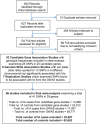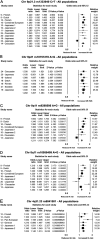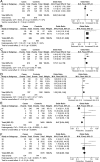Genetic risk factors for intracranial aneurysms: a meta-analysis in more than 116,000 individuals
- PMID: 23733552
- PMCID: PMC3716358
- DOI: 10.1212/WNL.0b013e318295d751
Genetic risk factors for intracranial aneurysms: a meta-analysis in more than 116,000 individuals
Abstract
Objective: There is an urgent need to identify risk factors for sporadic intracranial aneurysm (IA) development and rupture. A genetic component has long been recognized, but firm conclusions have been elusive given the generally small sample sizes and lack of replication. Genome-wide association studies have overcome some limitations, but the number of robust genetic risk factors for IA remains uncertain.
Methods: We conducted a comprehensive systematic review and meta-analysis of all genetic association studies (including genome-wide association studies) of sporadic IA, conducted according to Strengthening the Reporting of Genetic Association Studies and Human Genome Epidemiology Network guidelines. We tested the robustness of associations using random-effects and sensitivity analyses.
Results: Sixty-one studies including 32,887 IA cases and 83,683 controls were included. We identified 19 single nucleotide polymorphisms associated with IA. The strongest associations, robust to sensitivity analyses for statistical heterogeneity and ethnicity, were found for the following single nucleotide polymorphisms: on chromosome 9 within the cyclin-dependent kinase inhibitor 2B antisense inhibitor gene (rs10757278: odds ratio [OR] 1.29; 95% confidence interval [CI] 1.21-1.38; and rs1333040: OR 1.24; 95% CI 1.20-1.29), on chromosome 8 near the SOX17 transcription regulator gene (rs9298506: OR 1.21; 95% CI 1.15-1.27; and rs10958409: OR 1.19; 95% CI 1.13-1.26), and on chromosome 4 near the endothelin receptor A gene (rs6841581: OR 1.22; 95% CI 1.14-1.31).
Conclusions: Our comprehensive meta-analysis confirms a substantial genetic contribution to sporadic IA, implicating multiple pathophysiologic pathways, mainly relating to vascular endothelial maintenance. However, the limited data for IA compared with other complex diseases necessitates large-scale replication studies in a full spectrum of populations, with investigation of how genetic variants relate to phenotype (e.g., IA size, location, and rupture status).
Figures



References
-
- Rinkel GJ, Djibuti M, Algra A, van Gijn J. Prevalence and risk of rupture of intracranial aneurysms: a systematic review. Stroke 1998;29:251–256 - PubMed
-
- Rinkel GJ, Algra A. Long-term outcomes of patients with aneurysmal subarachnoid haemorrhage. Lancet Neurol 2011;10:349–356 - PubMed
-
- Clarke M. Systematic review of reviews of risk factors for intracranial aneurysms. Neuroradiology 2008;50:653–664 - PubMed
-
- Feigin VL, Rinkel GJ, Lawes CM, et al. Risk factors for subarachnoid hemorrhage: an updated systematic review of epidemiological studies. Stroke 2005;36:2773–2780 - PubMed
Publication types
MeSH terms
Grants and funding
LinkOut - more resources
Full Text Sources
Other Literature Sources
Medical
